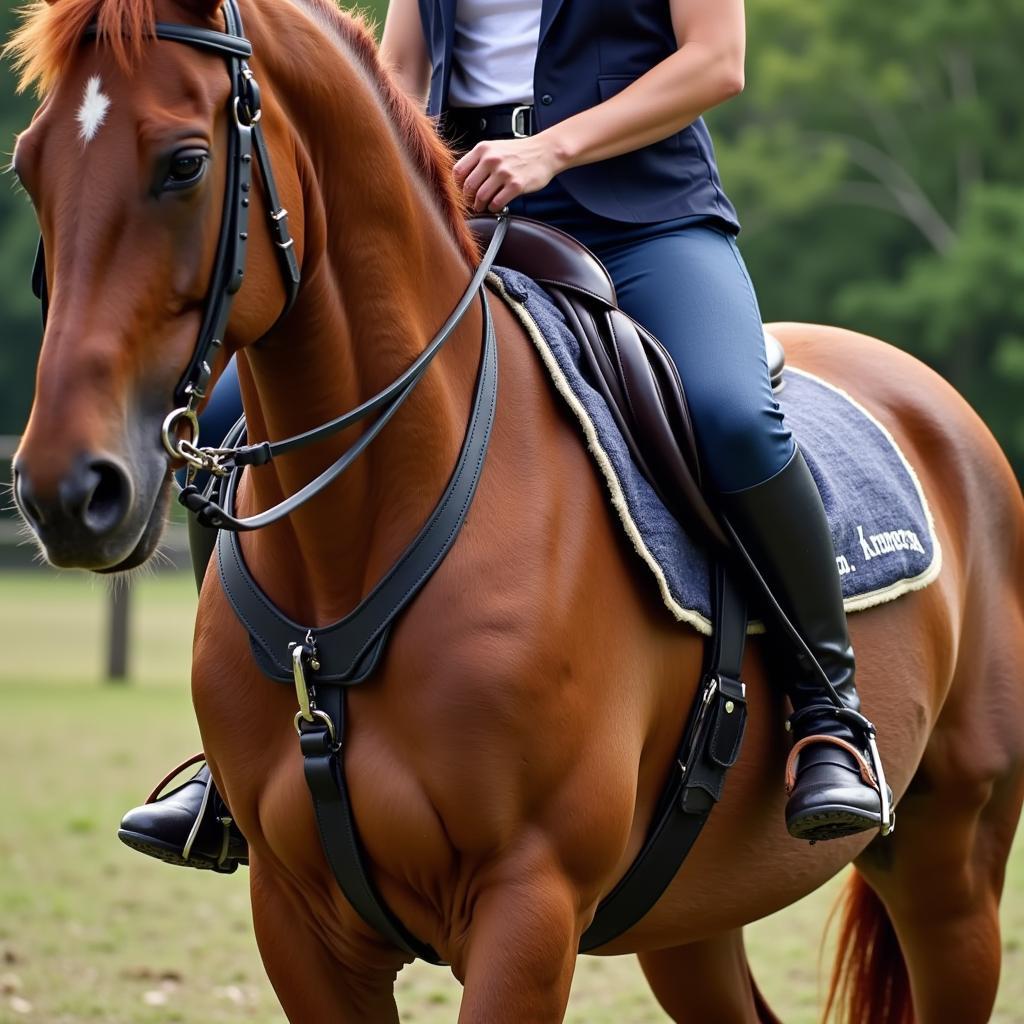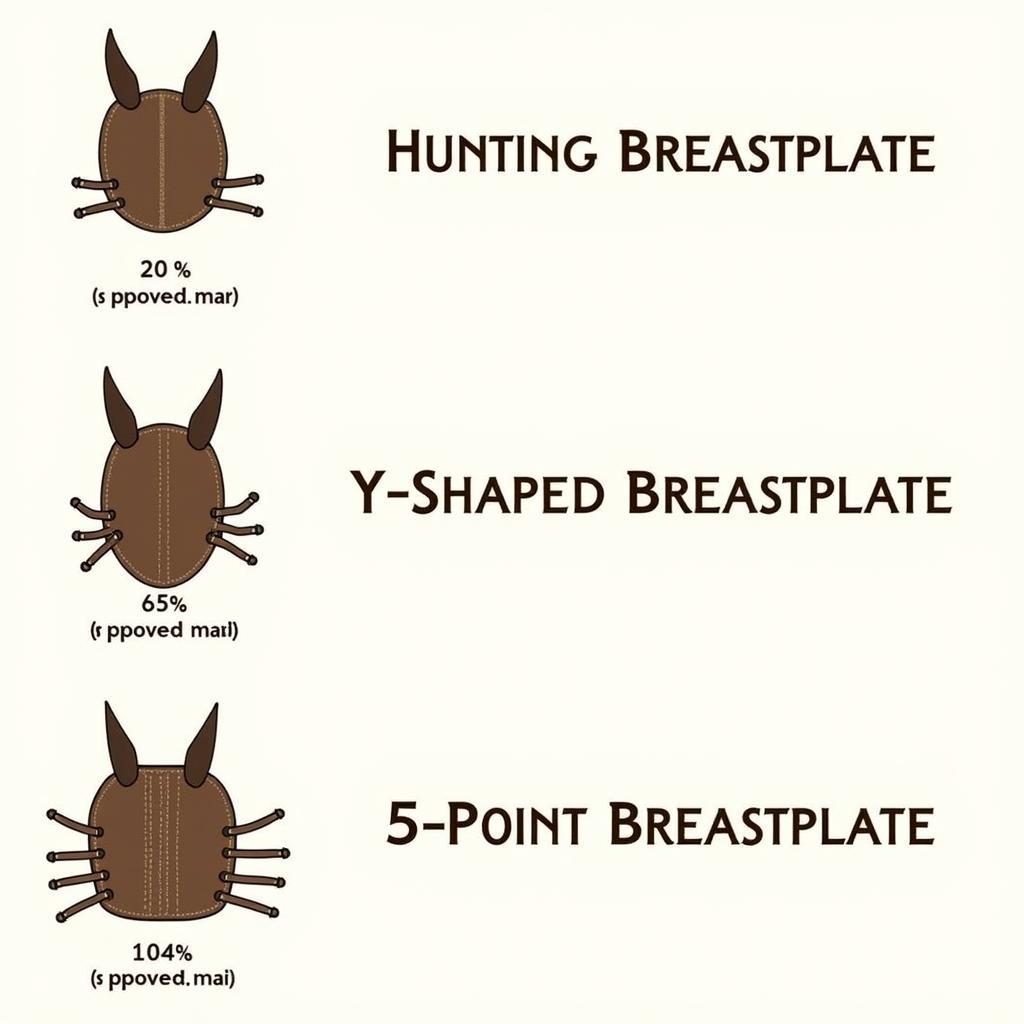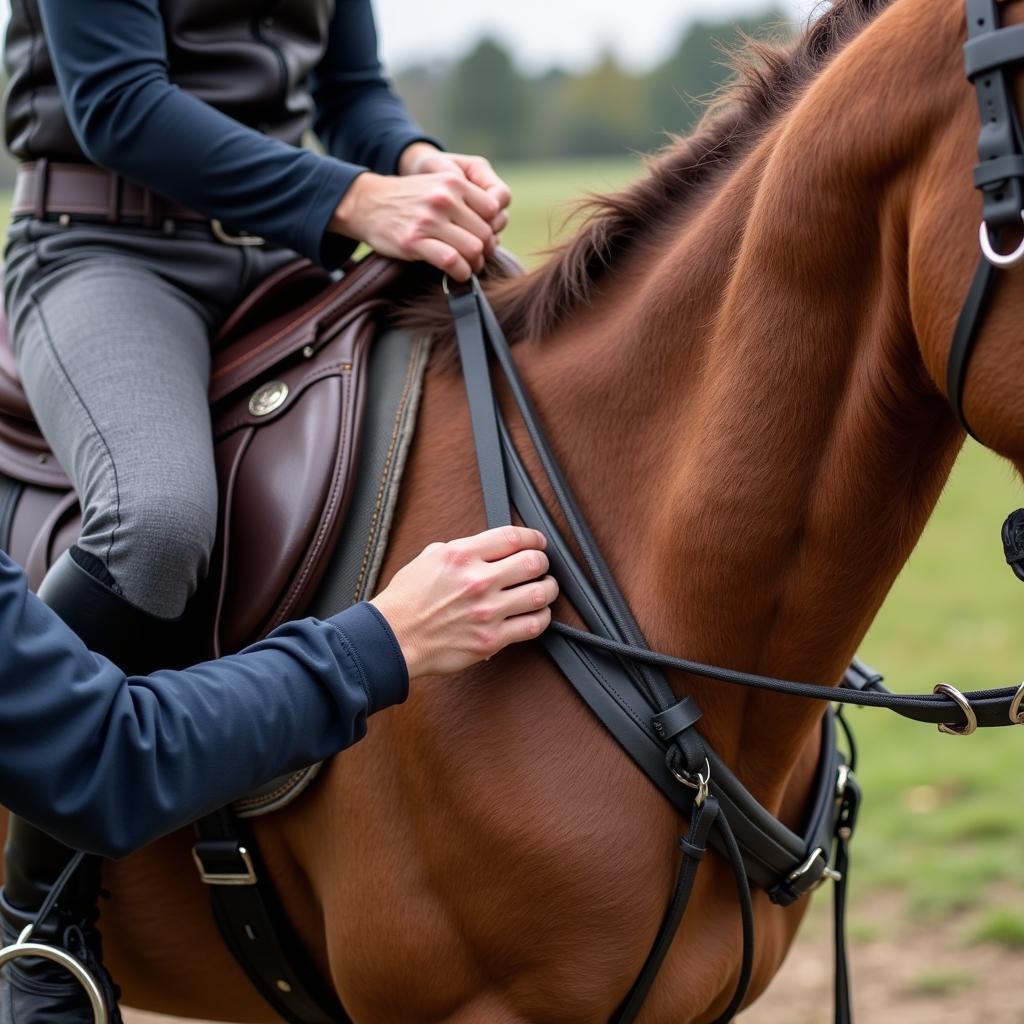A horse breastplate is an important piece of tack used to prevent saddles from slipping backward, especially on horses with a forward girth groove or those participating in disciplines requiring quick stops and turns. While often referred to as a “breastplate,” in English riding, the term encompasses several designs with subtle differences, including breastplates, breast collars, and 5-point breastplates.
 Horse Wearing a Breastplate in English Riding
Horse Wearing a Breastplate in English Riding
Understanding the Purpose of a Horse Breastplate English
In English riding disciplines like jumping, eventing, and even dressage, a breastplate helps to stabilize the saddle and distribute pressure evenly across the horse’s chest. This is particularly crucial during movements that engage the horse’s shoulders and back extensively.
Here’s why you might consider using a Horse Breastplate English:
- Preventing Saddle Slippage: The primary function of a breastplate is to prevent the saddle from sliding backward, which is especially important for horses with a more forward girth groove.
- Enhanced Saddle Security: By providing an additional point of attachment, a breastplate adds an extra layer of security, particularly important in dynamic riding disciplines.
- Improved Comfort: A well-fitted breastplate distributes pressure evenly across the chest, preventing pressure points and discomfort for the horse.
Types of Horse Breastplates
There are three main types of breastplates used in English riding:
- Hunting Breastplate: This classic design features a strap that runs across the horse’s chest, attaching to the girth between the front legs. Two straps extend up from the chest strap, connecting to D-rings located on either side of the saddle at the front. This type is commonly used in hunting and jumping.
- Y-Shaped Breastplate: As the name suggests, this breastplate forms a “Y” shape across the horse’s chest. The single strap that attaches to the girth splits into two straps that connect to the saddle’s D-rings. Y-shaped breastplates are popular in dressage and offer a clean, minimalist look.
- 5-Point Breastplate: This type combines features of the hunting and Y-shaped breastplates, adding an extra strap that runs between the front legs and attaches to the girth. This configuration offers maximum stability and is ideal for disciplines requiring intense movement.
 Types of Horse Breastplates
Types of Horse Breastplates
Choosing the Right Horse Breastplate English
When selecting a horse breastplate, several factors come into play:
- Discipline: The type of riding you do will influence the most suitable breastplate. Hunting breastplates are versatile, while Y-shaped breastplates are favored for their elegance in dressage. For eventing or other demanding disciplines, a 5-point breastplate might be necessary.
- Horse’s Conformation: Consider your horse’s build. Horses with a forward girth groove benefit greatly from a breastplate. If your horse has a wide chest, make sure the breastplate you choose has adjustable straps to ensure a comfortable fit.
- Material and Fit: Leather breastplates are the most traditional and offer durability. Synthetic materials are lighter and easier to clean. Ensure a snug but not restrictive fit, allowing for two fingers to fit comfortably between the straps and the horse’s body.
Fitting a Horse Breastplate English Correctly
A poorly fitted breastplate can hinder performance and cause discomfort. Here’s a step-by-step guide:
- Saddle Placement: Ensure your saddle is positioned correctly before fitting the breastplate. It should sit comfortably behind the horse’s shoulder blades.
- Attaching the Girth Strap: Fasten the girth strap first. It should be centered and lie flat against the horse’s chest. Adjust the length so that it doesn’t interfere with the girth or restrict the horse’s movement.
- Connecting to the Saddle: Attach the straps to the saddle’s D-rings, ensuring they are even and don’t pull the saddle out of place. The breastplate should lie flat against the horse’s shoulders without any gaps or twisting.
- Final Check: Once the breastplate is in place, walk your horse around and observe how it moves. The breastplate should remain in position without pinching, rubbing, or restricting the horse’s gait.
Caring for Your Horse Breastplate English
Regular cleaning and maintenance will prolong the life of your breastplate:
- Cleaning: After each use, wipe down your breastplate with a damp cloth to remove sweat and dirt. For leather breastplates, use a leather cleaner and conditioner regularly to keep the leather supple and prevent cracking.
- Storage: Store your breastplate in a cool, dry place, away from direct sunlight. Hang it on a saddle rack or store it in a well-ventilated tack room.
Expert Insights
“A well-fitted breastplate can make a world of difference in your horse’s comfort and performance, especially in disciplines that require a lot of movement,” says renowned equestrian coach, Sarah Williams. “It’s important to choose the right type of breastplate for your horse’s needs and ensure it fits properly to avoid any discomfort or restriction.”
 Adjusting a Horse Breastplate for English Riding
Adjusting a Horse Breastplate for English Riding
Conclusion
Choosing the right horse breastplate english is crucial for riders seeking to enhance saddle stability, distribute pressure evenly, and optimize their horse’s comfort and performance. Whether you’re a seasoned competitor or a recreational rider, understanding the different types of breastplates available and how to properly fit them is essential for a safe and enjoyable riding experience.
FAQs
1. Can I use a breastplate on any horse?
While breastplates are beneficial for many horses, not all horses require one. Horses with a forward girth groove or those participating in disciplines requiring dynamic movement often benefit the most from a breastplate.
2. What are the signs of a poorly fitted breastplate?
Signs of a poorly fitted breastplate include rubbing or sores on the horse’s chest, resistance to moving forward, or the breastplate slipping out of place.
3. How tight should a horse breastplate be?
A breastplate should fit snugly but not restrictively. You should be able to comfortably fit two fingers between the straps and the horse’s body.
4. Can I use a western breast collar for English riding?
Western breast collars are designed differently than English breastplates and are not suitable for English riding.
5. How do I know if my horse needs a breastplate?
If your horse’s saddle frequently slips backward, even with a properly fitted girth, a breastplate may be beneficial. Consult with a qualified equestrian professional for personalized advice.
For further assistance, please contact us at Phone Number: 0772127271, Email: [email protected] Or visit us at: QGM2+WX2, Vị Trung, Vị Thuỷ, Hậu Giang, Việt Nam. Our customer service team is available 24/7 to assist you.
Explore our website for additional resources, including our selection of cross country horse jumps for sale.